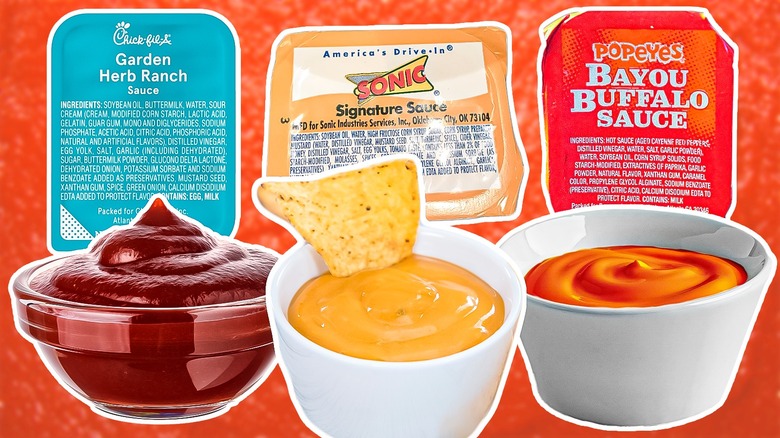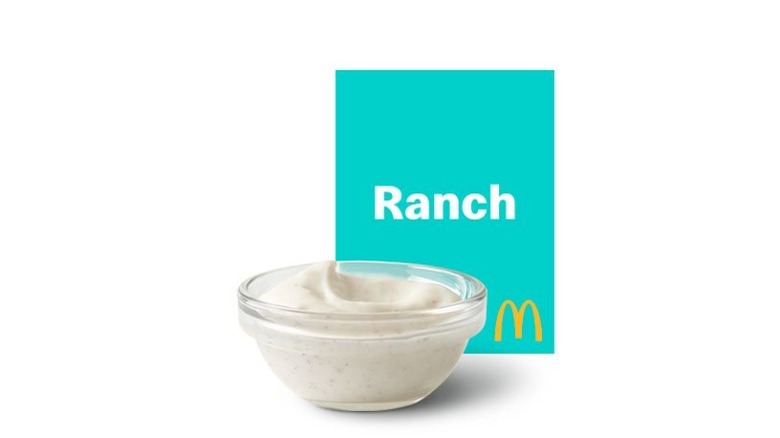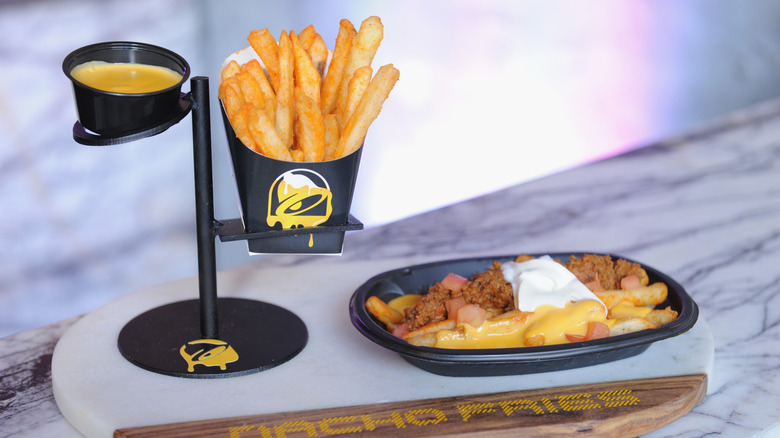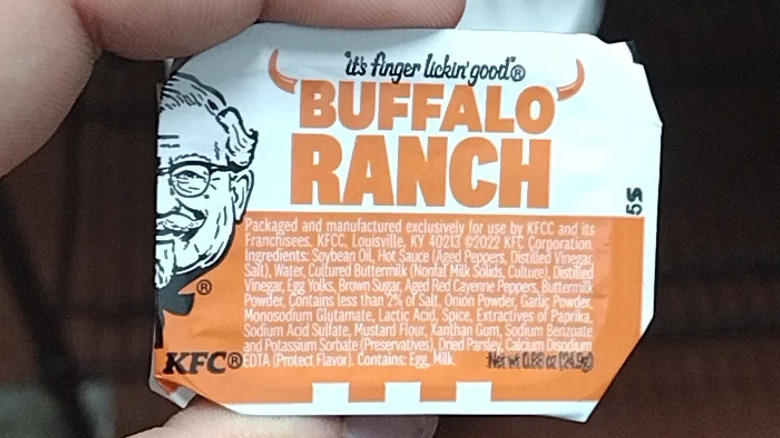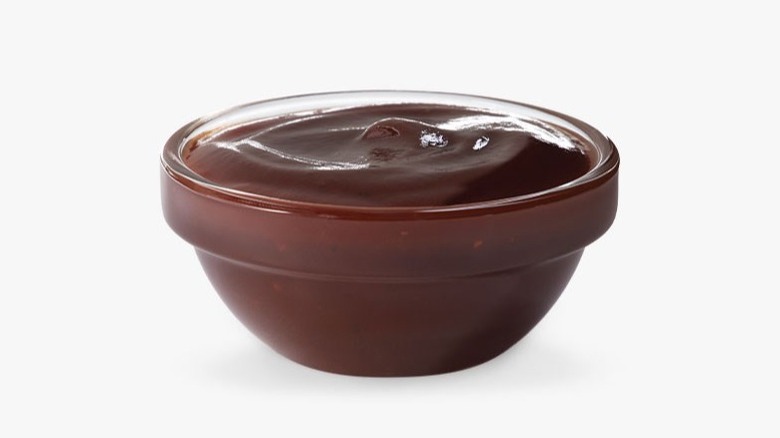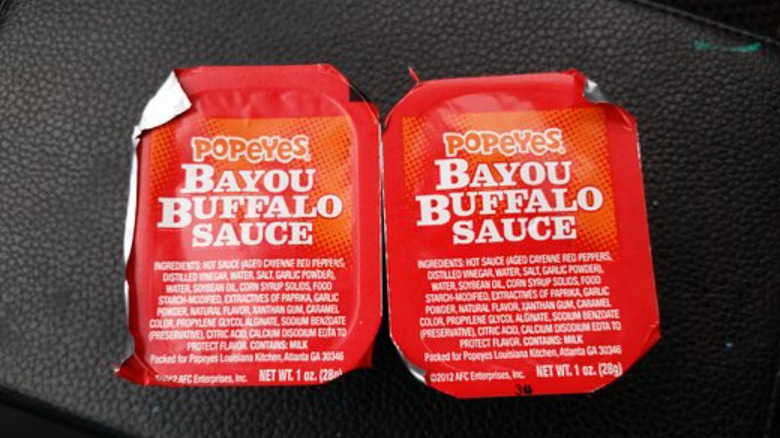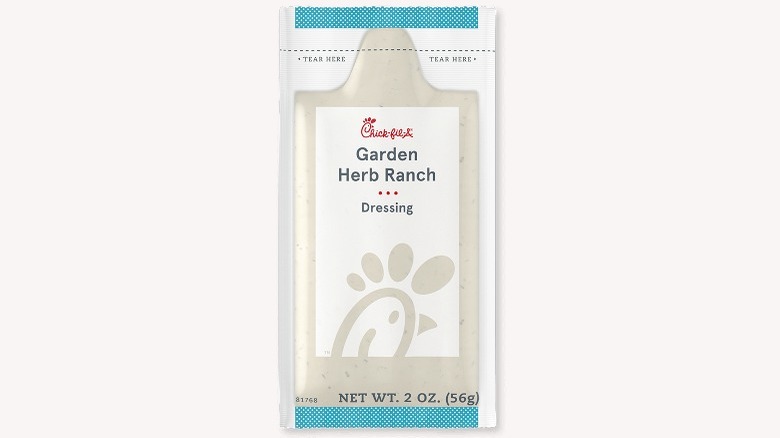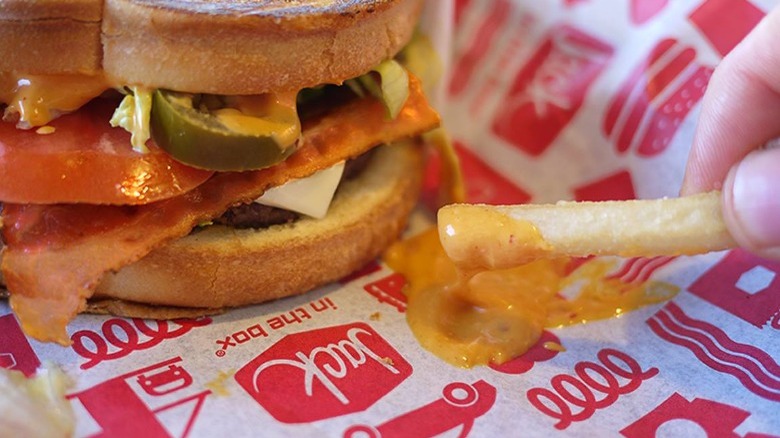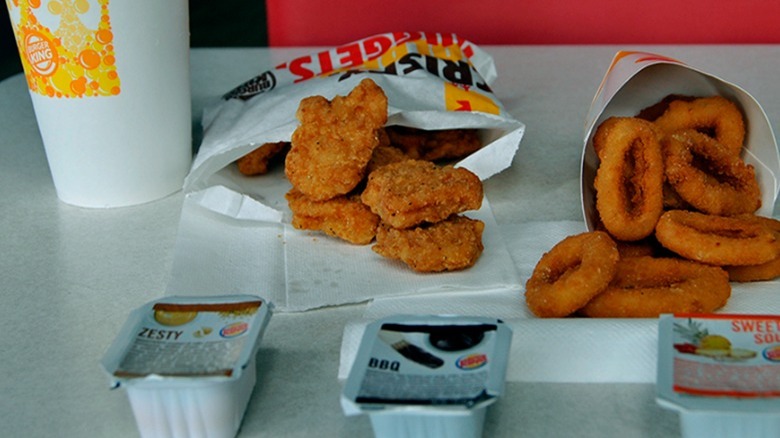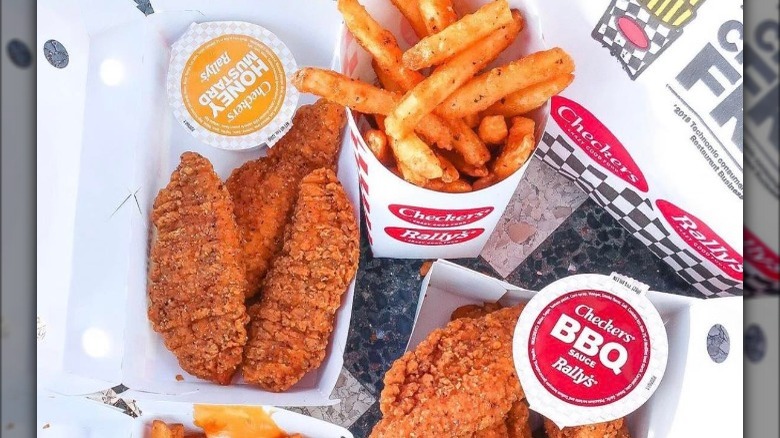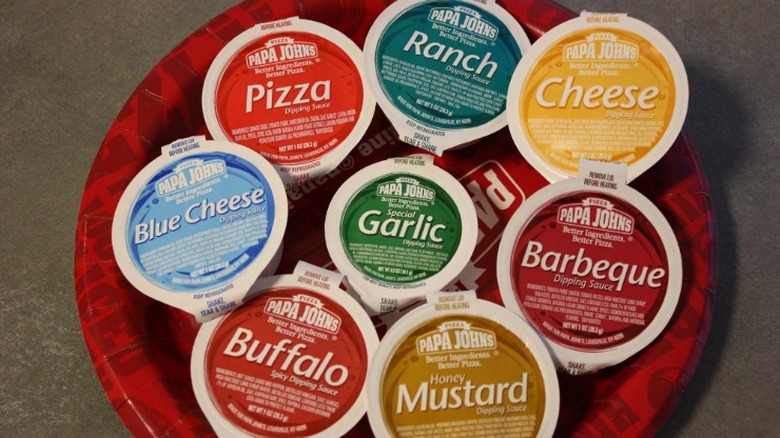Fast Food Dipping Sauces You Should Avoid At All Costs
When you roll up through the fast-food drive-thru, you're faced with a lot of decisions, weighing the pros and cons of various menu items based on factors be they fast food breakfast items or unique fast food burgers. While most fast food is perfectly enjoyable as part of a balanced diet that focuses on all things in moderation, you may want to avoid certain sauces for a variety of reasons, from taste to consistency — even to calorie count.
However, as you make that calculated decision at the drive-thru, don't make the mistake of absentmindedly asking for a few extra dipping sauces to go along with your chicken tenders or fries. Just like the condiments in your fridge, the dipping sauces at fast-food chains can be chockfull of extra sugar and sodium, in amounts that are honestly shocking for the tiny, dipping cup serving size. Here are a few fast-food dipping sauces you might want to particularly avoid in the near future.
McDonald's Creamy Ranch
Who doesn't love ranch dressing? Well ... actually a lot of people don't like ranch dressing — it's quite a divisive condiment — but that aside, if you love ranch dressing, you likely really love ranch dressing and ask for it in any dining situation imaginable. However, there are a few reasons why you might pass on ordering McDonald's Creamy Ranch sauce with your next order of McNuggets.
Just a single serving of McDonald's Creamy Ranch sauce comes with 12 grams of fat or about 18% of your daily recommended value. Plus, its very first, main ingredient listed is soybean oil. Soybean oil, as research from the University of California, Riverside, revealed in 2020, is the most popular oil for human consumption in the United States. However, soybean oil has been linked to all sorts of scary health issues, and the 2020 study found that the oil caused genetic changes in mice brains — leading researchers to believe that soybean oil could, in fact, impact neurological conditions ranging from mental health concerns to Alzheimer's.
Taco Bell's Nacho Cheese Sauce
Taco Bell's Nacho Cheese Sauce truly makes an amazing addition to just about everything on the chain's menu. Tacos? Yes. Nacho cheese fries? You betcha. A burrito or quesadilla? There's nothing better.
That said, if you're watching your fat intake, you may want to opt for one of Taco Bell's other sauces instead. The nacho cheese sauce, when ordered with a side of chips, also comes with 13 grams of fat and 280 milligrams of sodium. For those following a 2,000-calorie daily diet, Mayo Clinic recommends only consuming between 44 and 78 grams of fat per day, depending on your needs. If you're on the lower end of the fat-consuming spectrum, then that one little side of nacho cheese at Taco Bell could nearly account for 30% of your daily intake. In comparison, all of Taco Bell's hot sauce options contain zero fat, zero carbs, and zero sugar and are all even vegetarian.
KFC's Buffalo Ranch
KFC's Buffalo Ranch sauce is relatively new, released in October 2022. As evidenced by past menu items like the KFC Double Down, this chain likes to regularly combine two things that, on their own, are typically relatively unhealthy. Put them together and, sure, it's tasty, but it's also something you might think twice about ordering. In this fashion, the sauce blends Buffalo sauce (which is notoriously high in sodium) with ranch (which is notoriously high in fat), for a spicy, creamy, herby blend that was quickly made a permanent option on the KFC sauce line.
When comparing KFC's Buffalo Ranch to the other options on the menu, it's easy to see why this sauce stands out beyond just its unique flavor. The sauce offers 290 milligrams of sodium per serving, the most of all the menu's sauces and condiments (only KFC's ketchup comes close, at 250 milligrams). It also comes in with the second-highest fat content, only after the chain's original ranch. It also ties with the original ranch and KFC Sauce for the amount of cholesterol in each serving.
Culver's Sweet Baby Ray's BBQ Sauce
Barbecue sauce across the board often gets low marks for its high sugar content, and the Sweet Baby Ray's BBQ sauce at Culver's is no exception. The barbecue sauce contains 26 grams of sugar per serving, or about the equivalent of over six teaspoons of sugar. The American Heart Association recommends you eat no more than 24–36 grams of sugar per day, so you might actually be exceeding your recommended daily sugar intake with just one serving of Culver's barbecue sauce — and wouldn't you rather save all that sugar for a Culver's Concrete Mixer? What's more, the top first ingredient in this barbecue sauce is high fructose corn syrup, which is reason enough to avoid the sauce; high fructose corn syrup has been linked to health issues such as high blood pressure, diabetes, and insulin resistance.
However, the sugar isn't the only area where this sauce stands out from the pack. It also contains 450 milligrams of sodium per serving, so about a fifth of the amount the U.S. government recommends you eat per day.
Popeyes' Bayou Buffalo Sauce
Another fast-food dipping sauce that packs in the sodium is Popeyes' Bayou Buffalo sauce. With the most sodium out of all the chain's sauces, the Bayou Buffalo sauce contains 450 milligrams of sodium per serving. Sure, it doesn't have much else in it (for example, you'd do much better with the Bayou Buffalo sauce if you're avoiding extra sugar rather than salt, as it contains no sugar compared to the 16 grams found in the Popeyes' Sweet Heat sauce). However, if you want to cut down on your sodium intake, this is the sauce for you to steer clear of during your next Popeyes run.
That said, the sodium didn't keep this sauce from becoming a fan favorite. Introduced in 2012 as one of three new signature sauces, the Bayou Buffalo sauce is a typical Buffalo dipping sauce with a little bit of heat. Since then, fans have attempted to recreate the sauce at home, with copycat recipes, and to find similar sauces on store shelves, with mixed results.
Chick-fil-A's Garden Herb Ranch
Formulated to mimic the taste and texture of homemade from-scratch ranch dressing, Chick-fil-A's Garden Herb Ranch is the highest-fat sauce option on the chain's menu, at 15 grams. For a sauce-slash-dressing, it's pretty high in sodium too, at 220 milligrams per serving (though that can't stand up to Chick-fil-A's Zesty Buffalo Sauce and its 570 milligrams).
However, like many Chick-fil-A sauces, this ranch has gained a following — so much so that, in May 2023, Chick-fil-A announced it would be rolling out full-size bottles of the stuff in grocery stores nationwide. The 12-ounce bottles of Garden Herb Ranch are offered alongside an avocado lime ranch, apple cider vinaigrette, and a salsa-inspired dressing that you may have enjoyed on Chick-fil-A's Spicy Southwest Salad. These newly offered dressings and sauces are in addition to other sauces offered by Chick-fil-A, in stores, including the classic Chick-fil-A sauce, sriracha, barbecue, and Polynesian sauces. At the time of the announcement, Chick-fil-A recommended a few unique ways to use the bottled sauces, including putting the Garden Herb Ranch in your biscuits.
Jack-in-the-Box's Creamy Sriracha and Franks Red Hot Buffalo Dipping Sauces
If you've yet to jump on the sriracha train, now's the time. The cult-favorite sriracha is a hot sauce with Thai roots that's made its way to multiple fast-food menus over the last decade to much fanfare. Jack-in-the-Box is just one of these, and the chain has used its creamy sriracha sauce in a variety of ways, like on its Spicy Sriracha Burger and the Sriracha Curly Fry Burger. However you prefer to eat this sauce though, just know it packs 270 milligrams of sodium, making it the highest-sodium sauce among Jack-in-the-Box's sandwich sauces.
Jack-in-the-Box divides its sauces by sandwich and dipping sauces, though — and when it comes to dipping sauces, the creamy sriracha has nothing on the Franks Red Hot Buffalo Sauce offered by the chain, with its 730 milligrams of sodium. If that number worries you about the bottle of Franks Red Hot that you have in the fridge, you can breathe easier; the store-bought stuff only has 460 milligrams of sodium per serving. While that's still high, at nearly one-fifth of your daily allotment of sodium, it's certainly better than the Jack-in-the-Box variant.
Burger King's Zesty Onion Ring Sauce
Fries are standard fare at fast-food restaurants, but onion rings? They're a little bit harder to find. And an onion ring-specific dipping sauce? That's a particularly unique offering — but it's one you can get at Burger King. Customers love Burger King's Zesty Sauce, and for good reason. It's a little tangy, a little spicy, and overall zesty. For this reason, copycat recipes are plentiful and there was, in 2019, even a Zesty Sauce shortage.
Unfortunately, for all its zest, this sauce also comes with 240 milligrams of sodium, 20 milligrams of cholesterol (double what you'll find in the sauces with the second-highest amount of cholesterol on the Burger King menu), and 15 grams of fat, tying for highest-fat sauce on the Burger King menu with the chain's ranch. If you're looking for the overall healthiest sauce on the chain's menu, opt for the honey mustard dipping sauce, instead, with its comparative 180 milligrams of sodium, 10 milligrams of cholesterol, and 6 grams of fat.
Carl's Jr and Hardee's Spicy Buffalo Sauce
Twin fast-food chains Carl's Jr and Hardee's have put their Spicy Buffalo Sauce on a variety of menu items, from blue cheese french fries to their star-shaped chicken nuggets. However, while Buffalo sauce is a natural fit for chicken and blue cheese, it's not always going to be a natural fit for your health goals — particularly when it comes from Carl's Jr or Hardee's. The chains' Buffalo sauce boasts 470 milligrams of sodium, far more than their other sauces, which include honey mustard, barbecue, and ranch options. That said, the sauce is low on everything else, including fat, carbs, and sugar (particularly when compared to the Sweet & Bold BBQ Dipping Sauce, with its 11 grams of sugar and 12 grams of carbs).
If you've noticed a trend of Buffalo sauces being wildly salty, you're not alone. One Reddit user posed the question of why exactly hot sauces pack in so much sodium and many other users pointed out that, in sauces like these, salt acts as an all-natural preservative.
Sonic's Signature Cheese Sauce
Sonic's Signature Cheese Sauce was introduced in 2018 alongside another new menu item: A dippable, twisted, salted pretzel. Sure, the cheese sauce is a great fit for a pretzel, but it also can do so much more. Have it with your tots. Pour it on a burger. Dip your popcorn chicken in it. If you like a little cheesy goodness wherever you go, you'll like this cheese sauce.
The only problem? The Signature Cheese Sauce is packed with sodium and has some of the highest amounts of saturated fat of any other sauce on the menu. One serving of this sauce comes with 580 milligrams of sodium, more than any other sauce on the menu. Meanwhile, it offers 2 grams of saturated fat, the same as the Sonic ranch and second only to the cream cheese frosting that Sonic lists as one of its dipping sauces. Of the different types of fat you could consume, saturated fats aren't the most desirable. The U.S. government recommends limiting saturated fats and replacing them with unsaturated fats, as saturated fat can lead to heart disease and other health issues.
Checkers' and Rally's Medium Buffalo Sauce
Checkers and Rally's offers a plethora of dipping sauces and, if you've ever perused any Checkers menu hacks, you'll notice that a lot of said hacks include combining multiple or even all of the sauces into one, for pouring on other menu items like fries or hot dogs. However, as you pick out the sauces and dips you want to use during your next Checkers or Rally's order, you might want to think twice about ordering the Medium Buffalo Sauce.
While these restaurants offer multiple kinds of Buffalo sauces, it's the Medium Buffalo Sauce that's the worst offender, with its 870 milligrams of sodium. Thankfully, if you want to get your Buffalo fix without consuming so much extra salt, you do have some other options. Try out the restaurant's Frank's Buffalo Hot Sauce, which comes in at 730 milligrams of sodium. It's not great, but at least it's better than both the Medium and the Angry Buffalo options.
Papa Johns' Buffalo Sauce
There's no need to order Papa Johns' wings in order to enjoy the chain's Buffalo sauce. You can nab this sauce alongside your pizza, breadsticks, or any other menu item. However, keep in mind that, if you do, you'll be adding 900 milligrams of sodium to your meal, so inching up to nearly half the amount the U.S. government recommends you eat per day. When you consider that Papa John's other menu items are going to include their own fair shares of sodium, you might just be surpassing the healthy amount of sodium you could eat in a day — all in a single meal.
For a less-salty option, try Papa John's cheese sauce, with its 160 milligrams of sodium, or even the honey mustard, with its 120 milligrams of sodium per serving. You could also try making a low-sodium version of Papa Johns' Buffalo sauce at home. One Redditor claims that Papa John's Buffalo sauce recipe is literally just a bottle of Frank's Red Hot and a pound of melted butter.
